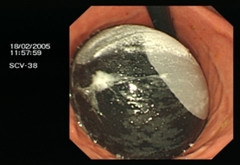 |
|
Weight Reduction Procedures Risk of Surgery Who Need Surgery Choice of Procedures Metabolic Surgery Life after Surgery |
INTRAGASTRIC BALLOON (IGB) PROGRAM What is Intra-gastric Balloon The use of an intragastric balloon in the treatment of obesity and morbid obesity has been a well-known practice. The idea of using a gastric space-occupying volume device, giving a sensation of satiety, for the control of obesity was first described in 1982. However, in the mid 1980's, poorly designed balloons had numerous complications leading to spontaneous and early deflations, balloon displacement, and intestinal obstruction. Not until 1990's, a new type of intragastric balloon with improved design which offers numerous advantages and has become a clinically accepted method of treatment of obesity in Europe and south America.  IGB treatment program aims at
behavioral modification of poor eating habit through sense of satiety created by IGB,
together with dietetic supervision of low calorie meal during the 6 months treatment period. The use of the intragastric
balloon in the treatment and management of morbid obesity is not a panacea; correct patient selection and respect of
the dietetic and behavioral program are key factors in obtaining successful results. Experience in Hong Kong reviewed
in average 10-12 kg of weight can be lost by IGB program. Nevertheless, after the removal of the balloon, weight-regain
is possible. It is thus not a long-term solution of obesity and can never replace surgery in morbidly obese individuals.
However, in selective group of patient who is not suitable for surgery, IGB program is a valid alternative in controlling
the body weight. IGB treatment program aims at
behavioral modification of poor eating habit through sense of satiety created by IGB,
together with dietetic supervision of low calorie meal during the 6 months treatment period. The use of the intragastric
balloon in the treatment and management of morbid obesity is not a panacea; correct patient selection and respect of
the dietetic and behavioral program are key factors in obtaining successful results. Experience in Hong Kong reviewed
in average 10-12 kg of weight can be lost by IGB program. Nevertheless, after the removal of the balloon, weight-regain
is possible. It is thus not a long-term solution of obesity and can never replace surgery in morbidly obese individuals.
However, in selective group of patient who is not suitable for surgery, IGB program is a valid alternative in controlling
the body weight.How Is the Intragastric Balloon Placed in the Stomach?  The balloon is introduced
into the stomach through the mouth without the need for surgery. The physician conducts an
initial examination of the stomach using an endoscopic camera. If no abnormalities are observed, the physician proceeds
with placement of the balloon through the mouth and down the oesophagus into the stomach. The balloon is made of a soft
and pliable silicone material and is inserted while in its smallest, deflated form. The swallowing process is made easier
with the help of anaesthetics applied topically to numb the throat area. The balloon is introduced
into the stomach through the mouth without the need for surgery. The physician conducts an
initial examination of the stomach using an endoscopic camera. If no abnormalities are observed, the physician proceeds
with placement of the balloon through the mouth and down the oesophagus into the stomach. The balloon is made of a soft
and pliable silicone material and is inserted while in its smallest, deflated form. The swallowing process is made easier
with the help of anaesthetics applied topically to numb the throat area.When the balloon is well within the stomach, it is filled with approximately 500cc of saline fluid. The procedure lasts approximately twenty minutes and is performed on an out-patient basis. Who Can Join the IGB program? In 2004, we established a new IGB program for those patents who is not suitable or do not consent for operative bariatric surgery. In this program, IGB therapy is used as a temporary weight control measure in three groups of patients:
How Long Is the IGB Used? The balloon currently can be used for six months. Longer periods of use are not recommended. Over time the acidic content of the stomach will weaken the balloon material and cause the balloon to deflate. After 6 months, the balloon is removed in the same way it was placed, via the oesophagus and mouth. What Unpleasant Effects Are Possible with the IGB program?
Will I Regain My Weight after the Intragastric Balloon Is Removed? Because the balloon in the stomach creates a feeling of fullness, it acts as an aid to weight reduction and may help you to adhere to a prescribed diet. You will have a much greater chance of maintaining your weight loss after balloon removal if you maintain and improve the diet and behavior changes you made while using the balloon. In our experience, 30% of patients can maintain more than 10% of their lost weight in average of 12 months after balloon removal. |